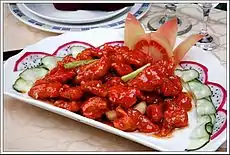Lychee pork
Lychee pork or lizhi rou (Chinese: 荔枝肉; pinyin: lìzhī ròu; Eastern Min: liĕk-chiĕ-nṳ̆k) is one of the most well known dishes in Fujianese cuisine. Small pieces of deep fried pork and sliced water chestnut are served in a sweet and sour sauce. As is typical in Fujian, red wine lees are used to add flavor and give bright red color. The pork pieces curl up and are stained red, thus resembling lychee skins, hence the name.[1]
 | |
| Alternative names | Lizhi rou |
|---|---|
| Place of origin | China |
| Region or state | Fujian |
| Main ingredients | pork |
| Ingredients generally used | water chestnut, red wine lees |
Origins in China
Lychee pork is a traditional dish in the cities of Fuzhou, Putian and some southeastern areas of Fujian in China, with a history stretching back 200–300 years.[2] It is highly representative of Min cuisine. Lychee pork is so named because it resembles the mature fruit of the lychee. The curling of the pork comes from the crosswise cutting pattern of the meat, creating the characteristic shape when cooked. The taste mixes sweet and sour, which is common in southern Chinese cuisine; the sauce is commonly done with ketchup, soy sauce and rice vinegar. The additional vegetable ingredients are yams, water chestnut, tomatoes, and green onions.[3]
Associated Legends
One of the most widely told legends associated with lychee pork concerns one of the concubines of the Xuanzong Emperor of the Tang Dynasty, Consort Mei of the Jiang clan, whose hometown was Putian, Fujian. Because of the considerable distance from the Imperial Court to her hometown, she frequently grew homesick, and only lychees from her hometown could cure of her despondency. She also employed a chef, Jiang (Chinese: 老蒋头; pinyin: lǎo jiǎng tóu), who devised an ingenious way of cooking meat so that it resembled one of these lychees, and from then on it became a delicacy in her palace. Although Consort Mei was killed in the Anshi Rebellion, the tradition goes that the chef escaped and fled back to Fujian, bringing it to the populace.[4]
Lychee pork in the USA
Outside China, lychee pork forms the rudiments of some famous Chinese restaurant dishes. Chicken balls and pork balls are two common dishes that customers can order in North American Chinese restaurants. Two hundred years ago, the first group of Chinese from Guangdong and Fujian crossed the Pacific Ocean to the West Coast of America, due to poverty in their hometowns and the prospect of work in the construction of American railroads. Due to the lack of integration into American society at large, the offspring of these immigrants opened up Chinese takeaways and restaurants, bringing the cooking skills from their hometown and modified traditional southern Chinese cuisine (including lychee pork) into American food in order to earn their living. Today, we can still find many similarities between lychee pork and chicken/pork balls.[5]
See also
References
- 特級校對陳家廚坊︰請客吃飯 (in Chinese). 萬里機構出版有限公司. p. 46. ISBN 9789621452184.
- "名菜荔枝肉——甜中微酸的味道". sh.qihoo.com. Retrieved 2019-02-08.
- "荔枝肉的来历_百度文库". wenku.baidu.com. Retrieved 2018-11-26.
- "名菜荔枝肉——甜中微酸的味道". sh.qihoo.com. Retrieved 2019-02-08.
- "讲述荔枝肉的来历与典故 - 第一星座网". www.d1xz.net (in Chinese). Retrieved 2018-11-26.
